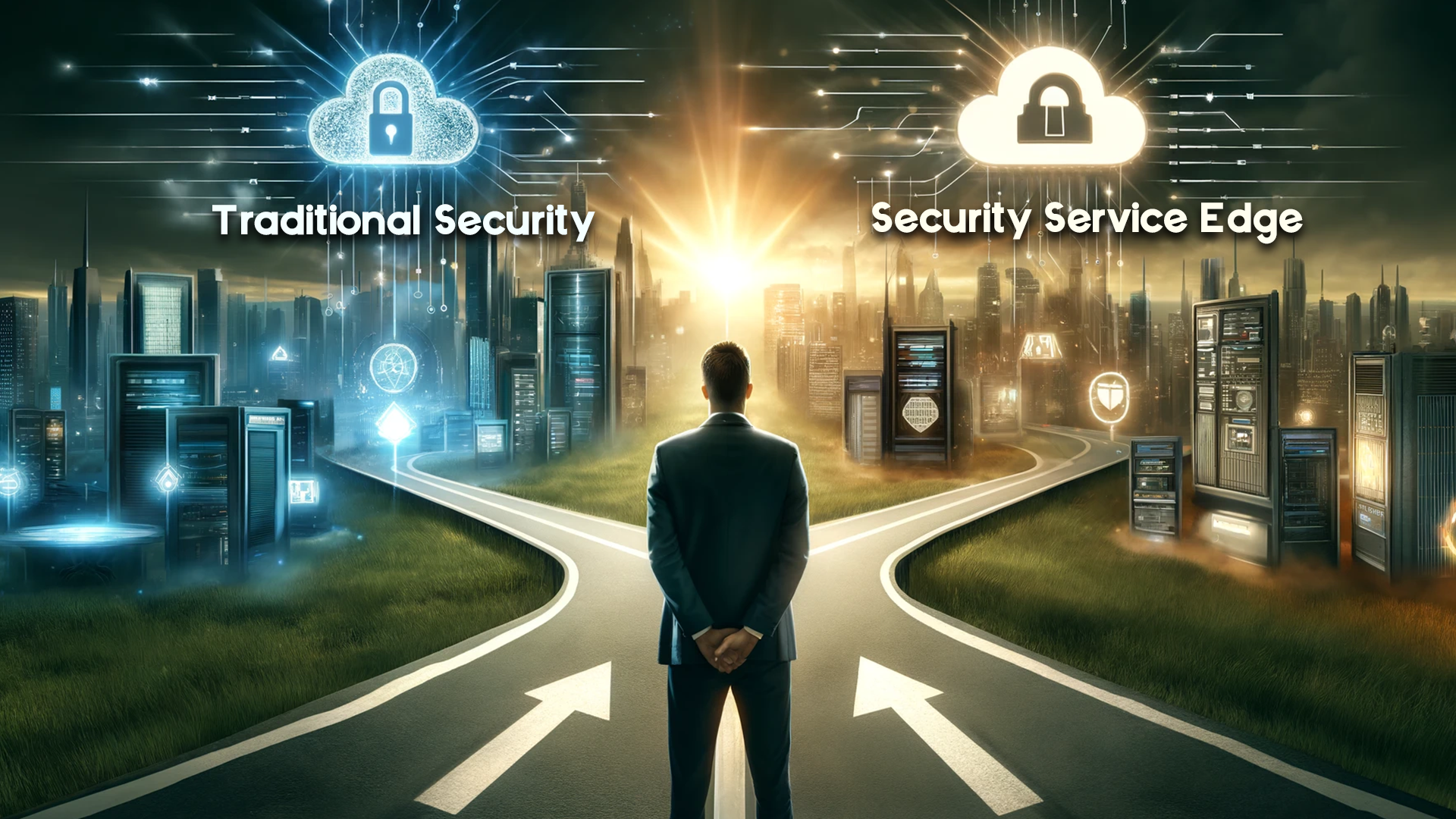
Thank you
Our team of industry domain experts combined with our guaranteed SLAs, our world class technology .


Get Immediate Help
In the ever-evolving realm of cybersecurity, the battle between traditional network security and Security Service Edge (SSE) is heating up. As cloud computing, remote workforces, and digital transformation redefine organisational landscapes, it's crucial to understand the nuances of these security approaches. Let's investigate a comparative analysis to know their differences, benefits, and implications for modern organisations.

Perimeter-Based vs. Edge-Based Security: Traditional network security relies on a centralised perimeter, like firewalls and intrusion detection systems (IDS), to safeguard the network. However, SSE introduces an edge-based model, distributing security controls closer to users and devices regardless of location. This shift is vital for securing decentralised environments prevalent in today's dynamic work settings.
Focus on Network vs. User and Data Security: While traditional network security prioritises network defence, Security Service Edge takes a more holistic approach, focusing on user and data security management. SSE solutions such as Cloud Access Security Brokers (CASBs) ensure visibility and control over cloud application usage and data storage, addressing the evolving security needs of modern organisations.
Scalability and Adaptability: Scaling traditional security solutions can be cumbersome and expensive, especially with the adoption of new Cloud network security services. Conversely, Security Service Edge, being cloud-based and inherently scalable, offers seamless adaptability to changing security requirements. This scalability is crucial for organisations navigating the complexities of Digital protection.
User Experience and Remote Work: Traditional security solutions often face challenges in supporting remote workforces, resulting in degraded user experience due to centralised traffic routing. In contrast, SSE solutions are designed with remote work in mind, providing efficient and secure access to resources from anywhere. This user-centric approach enhances productivity and flexibility for modern organisations.
Security Features and Functionality: Traditional network security is often limited to basic functionalities like firewalls and VPNs, necessitating additional point solutions for comprehensive security. Security Service Edge, on the other hand, consolidates essential security functionalities such as Secure Web Gateways (SWG) and Zero Trust Network Access (ZTNA) into a unified platform. This integration streamlines security management and reduces complexity for organisations.
Alignment with Zero Trust Principles: While traditional network security may fall short in fully aligning with Zero Trust principles, SSE embraces these principles by incorporating functionalities like ZTNA and least privilege access controls. This alignment strengthens the organisation's security posture, emphasising continuous verification regardless of the user's location.

Organisations must carefully assess their infrastructure, Cloud network security adoption, and security requirements when selecting between traditional network security and SSE. While traditional security may suffice for on-premises environments, Security Service Edge offers a more robust and adaptable solution for cloud-centric organisations with remote workforces and zero-trust security principles.
Several Microminder CS services align closely with the challenges and requirements highlighted in the comparison between Security Service Edge (SSE) and traditional network security. Here's how some of these services can be beneficial for organisations:
1. Secure Service Edge (SSE): As discussed in the blog, SSE offers a modern security approach that aligns well with the evolving cybersecurity landscape, including cloud computing, remote workforces, and Zero Trust principles. Microminder's SSE solutions provide a cloud-delivered security framework designed to protect data across various environments, making them ideal for organisations seeking enhanced security in Digital protection.
2. Cloud Security Assessment Services: With the increasing adoption of cloud computing, organisations need to ensure the security of their cloud environments. Microminder's Cloud Security Monitoring Services help organisations assess the security posture of their cloud infrastructure, identify vulnerabilities, and implement necessary controls to mitigate risks effectively.
3. Zero Trust Network Access (ZTNA): Microminder offers ZTNA solutions that align with Zero Trust principles, providing the least privilege access controls and continuous verification regardless of user location. These solutions enhance security by minimising the attack surface and protecting critical resources from unauthorised access attempts.
4. Secure Web Gateway (SWG) Services: Given the importance of web traffic filtering and protection against online threats, Microminder's Secure Web Gateway solutions offer comprehensive web security functionalities. They help organisations with Website Security, prevent malware downloads, and filter out phishing attempts, safeguarding users and data from various online threats.
5. Threat Intelligence and Hunting Services: Microminder's Threat Intelligence and Hunting Services provide organisations with real-time threat intelligence feeds and proactive threat-hunting capabilities. By leveraging threat intelligence data, organisations can identify and mitigate emerging threats, enhancing their overall security posture and resilience against cyberattacks.
6. Managed Detection and Response (MDR) Services: With the growing sophistication of cyber threats, organisations require robust detection and response capabilities to detect and mitigate security incidents effectively. Microminder's MDR services offer continuous monitoring, threat detection, and incident response support, helping organisations identify and respond to security incidents on time.
7. Cyber Security Incident Response Retainer: In the event of a security incident, organisations need a well-defined incident response plan and access to experienced incident responders. Microminder's Cyber Security Incident Response Retainer provides organisations with access to a team of experienced incident responders who can assist in managing and responding to security incidents effectively.
These Microminder services offer a comprehensive suite of cybersecurity solutions that address the challenges highlighted in the comparison between Security Service Edge and traditional network security. By leveraging these services, organisations can enhance their security posture, mitigate risks, and Digital protection.
In conclusion, the cybersecurity landscape is evolving rapidly, demanding a shift from traditional network security to Security Service Edge. By embracing SSE, organisations can fortify their defences, adapt to changing security needs, and find the complexities of Digital protection.
At Microminder, we understand the challenges organisations face in safeguarding their digital assets. With our comprehensive suite of cybersecurity services, including Secure Service Edge solutions, we empower businesses to stay ahead of emerging threats and secure their digital future. Contact us today to discover how Microminder CS can help you elevate your cybersecurity posture and protect what matters most.
Don’t Let Cyber Attacks Ruin Your Business
Call
UK: +44 (0)20 3336 7200
KSA: +966 1351 81844
UAE: +971 454 01252
Contents
To keep up with innovation in IT & OT security, subscribe to our newsletter
Recent Posts
Penetration Testing | 10/11/2025
Cloud Security | 07/11/2025
Cybersecurity | 06/11/2025
How does Security Service Edge differ from traditional network security?
Unlike traditional network security, which relies on a centralised perimeter-based approach, SSE adopts an edge-based model, distributing security controls closer to users and devices regardless of location. SSE emphasises user and data security, scalability, and adaptability to address the challenges posed by cloud computing, remote work, and evolving cyber threats.What are the key components of SSE?
The key components of SSE include Cloud Access Security Broker (CASB), Secure Web Gateway (SWG), Zero Trust Network Access (ZTNA), data encryption, threat intelligence, and remote browser isolation. These components work together to provide multi-layered protection for data and users across cloud environments and remote workforces.How does Security Service Edge enhance data security?
SSE enhances data security by providing visibility and control over cloud application usage and data storage, enforcing security policies, encrypting data in transit and at rest, and leveraging threat intelligence to identify and mitigate emerging threats. By prioritising data security and aligning with Zero Trust principles, SSE helps organisations protect sensitive data from unauthorised access and data breaches.What are the benefits of implementing SSE?
Some benefits of implementing SSE include improved data security, enhanced user experience for remote workers, scalability and adaptability to accommodate evolving security needs, simplified security management, and alignment with Zero Trust principles. SSE enables organisations to effectively protect their digital assets in today's cloud-centric and distributed environments.How can organisations transition to Security Service Edge?
Organisations can transition to SSE by assessing their current security posture, identifying gaps and vulnerabilities, selecting appropriate SSE solutions and services, implementing security controls, and continuously monitoring and optimising their security infrastructure. Partnering with experienced cybersecurity providers can also facilitate the transition to SSE and ensure effective security implementation.